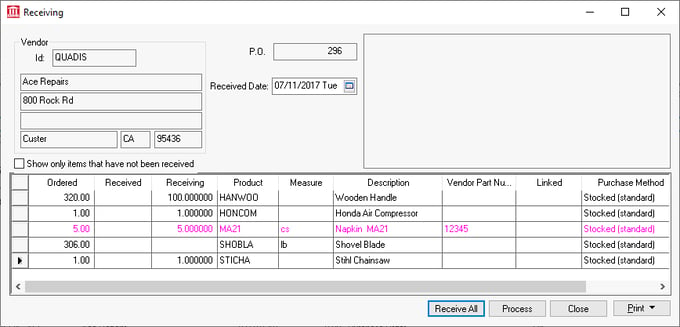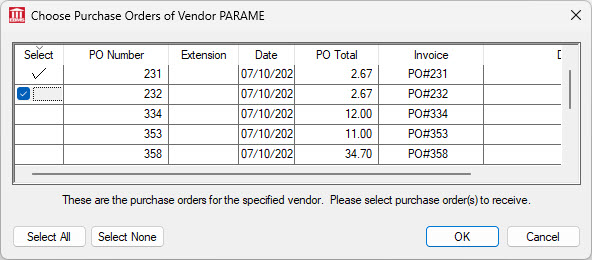- EBMS Knowledge Base
- Inventory
- Receiving Product
-
Client Resources
-
EBMS Main Documentation
- Introduction
- Getting Started
- Getting Started | Initial Installation
- Getting Started | Company Setup
- Quick User Guide | Financial Staff | Accountant
- Quick User Guide | Financial Staff | Accountant | Accountants Journal
- Quick User Guide | Sales Staff
- Quick User Guide | General Staff
- Features
- Reports
- Security
- Server Manager
- Technical
- Technical | Data Import and Export Utility
- Technical | SQL Mirror
- Automotive
- Automotive | Parts Catalog
- Automotive | Pricing
- Automotive | Point of Sale
- Automotive | Product Application
- Automotive | Keystone Interface
- Metal Supply
- Fuel Sales
- Horticulture
- Horticulture | Farm Setup
- Horticulture | Processing Payroll
- Horticulture | Managing the Farm
-
Sales
- Introduction
- Customers
- Customers | Miscellaneous Customers
- Proposals
- Proposals | Processing Proposals
- Proposals | Sets and Templates
- MyProposals
- MyOrders
- Sales Orders
- Invoices
- Materials Lists
- Sales and Use Tax
- Sales and Use Tax | TaxJar
- CRM
- CRM | Auto Send
- Recurring Billing
- Credits
- Customer Payments
- Payment Card Processing
- Payment Card Processing | Gift Cards
- Payment Card Processing | Loyalty Cards
- Payment Card Processing | Verifone Gateway
- Freight and Shipping Tools
- General Ledger Transactions
- Point of Sale
- Point of Sale | Point of Sale Hardware
- Point of Sale | Xpress POS System
- Point of Sale | Advanced Tools
- Signature Capture
- Salesperson Commissions
-
Inventory
- Product Catalog
- Product Catalog | Using Product Codes for No Count Items
- Product Pricing
- Product Pricing | Special Pricing
- Tracking Counts
- Unit of Measure
- Purchasing
- Special Orders and Drop Shipped Items
- Receiving Product
- Barcodes
- MyInventory and Scanner
- Components (BOM) and Accessories
- Components (BOM) and Accessories | Component Formula Tool
- Made-to-Order Kitting
- Configure-to-Order Kitting
- Multiple Inventory Locations
- Multiple Inventory Locations | Creating Locations
- Multiple Inventory Locations | Using Multiple Locations
- Multiple Inventory Locations | Product Catalog Sync
- Multi-Vendor Catalog
- Serialized Items
- Serialized Items | Purchasing or Manufacturing an Item
- Serialized Items | Selling and/or Associating an item with a customer
- Lots
- Product Attributes
- Product Attributes | Selling and Purchasing Items with Attributes
- Product Attributes | Custom Attributes
- Mobile Scanner (Legacy)
-
Labor
- Getting Started
- Workers
- Taxes and Deductions
- Work Codes
- Time and Attendance
- Time and Attendance | Time Track App
- Processing Payroll
- Closing the Payroll Year
- Processing Payroll - Advanced
- Salaried Pay
- Piecework Pay
- Direct Deposit
- 3rd Party Payroll Service
- Subcontract Workers
- Flag Pay
- Prevailing Wages
- MyDispatch
- MyTasks
- MyTime
- MyTime | Communications
- MyTime | Setup
- Tasks
- Tasks | Getting Started
- Tasks | Creating Tasks
- Tasks | Scheduling Tasks
- Tasks | Customizing Task Views
- Tasks | Managing Tasks
-
Financials
- Introduction
- Fiscal Year
- Chart of Accounts
- Budget
- Financial Reporting
- Transactions and Journals
- Transactions and Journals | Journals
- Account Reconciliation
- 1099
- Departments and Profit Centers
- Fund Accounts
- Bank Accounts
- Bank Feed
- Vendors
- Vendors | Miscellaneous Vendors
- Purchase Orders
- Expense Invoices
- Vendor Payments
- AP Transactions
- Landed Cost
- Fixed Assets and Depreciation
- Fixed Assets and Depreciation | Fixed Assets
- Fixed Assets and Depreciation | Fixed Assets | Adding Assets
- Fixed Assets and Depreciation | Processing Depreciation
- Fixed Assets and Depreciation | Disposing Assets
- MyJobs
-
E-commerce
-
Rental
-
Job Costing
-
Manufacturing
Receiving Dialog
A purchase order is used to identify the quantity and cost of the products that are ordered. If the received column within the purchase order is zero, the inventory items are recorded in inventory as ordered, but do not affect the total on hand count.
The Receiving Window associates all the back orders from purchase orders into a single screen rather than processing each purchase order separately. Note that back order line is not going to be associated if its description has been changed. The benefits of this window is limited if no purchase order back orders are created. The Receiving Window allows a user to split purchase orders based on back orders. The back order is based on the quantity received and the date that product was received. The row will be highlighted red if there was a problem in connecting the lines between backorders or if the numbers don't add up correctly.
Complete the following steps to receive items using the Receiving window:
-
Go to Expenses > Receiving option on the EBMS menu to open the following dialog:

-
Enter the Vendor ID that product is purchased from.
-
Select a P.O. from the open purchase orders for the current vendor. Click Select All to receive from any open purchase order. The system will load all back orders and invoices that contain the specified P.O.

-
Enter the amounts received into the Receiving column. Click the Receive All button to populate the Receiving column with the balance. This value may be restricted to the ordered quantity by setting the Expenses > Options > Invoices and P.O.s > allow Received quantity to exceed Ordered option. Review Barcodes > Limit Over-Assignment to limit quantity received to the amount ordered.
-
All products that are needed to fill Unfulfilled Sales Orders will show a different color. Right-click on any purchase order line and select Unfulfilled Sales Orders from the context menu to view the sales order.
-
Click the Process button to process. The Total on Hand count within the Inventory > Count tab of each item is affected by the amount on the purchase order. A back order is created if not all items have been received. The back order document will be labeled as ####.1 etc.
-
The Receiving values will be copied to the Received column. Double click on any purchase order line to view received purchase orders or invoices.
Open the purchase order from the purchasing dialog to print product labels. Review Printing Labels and Reports for more details.
This process only updates inventory counts and does not update financial values such as accounts payable or inventory asset totals. Receiving product will add the item(s) to the inventory Count and remove them from the P.O. Ordered and Received values of the inventory count tab. Review [Financials] Expense Invoices > Processing an Invoice to process the purchase order into an expense invoice and update
